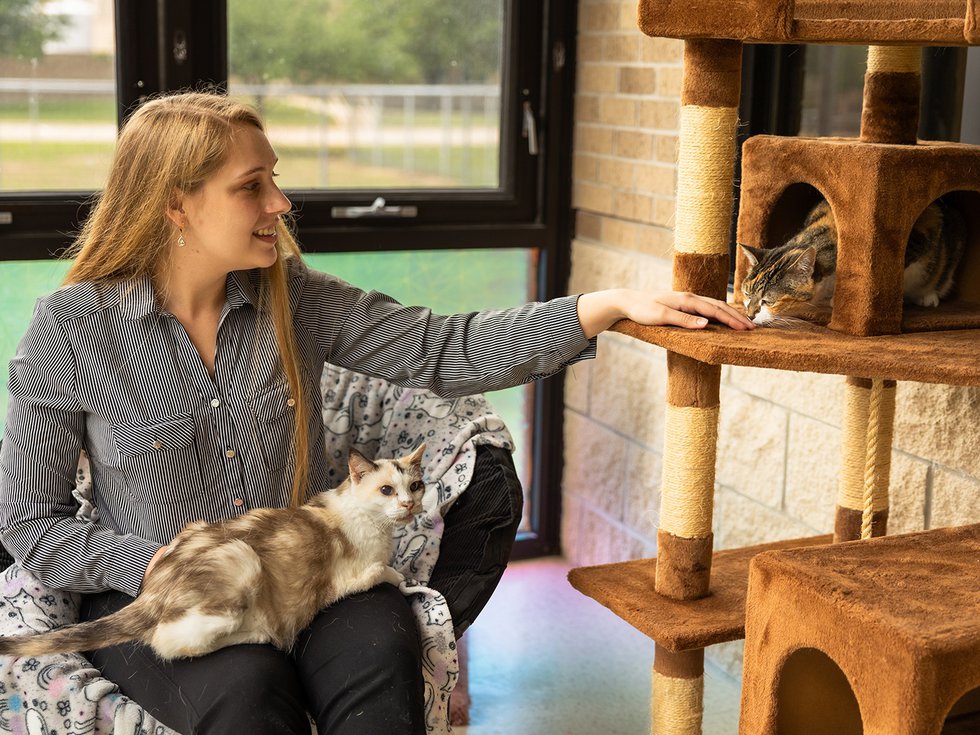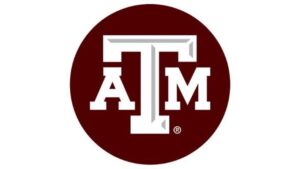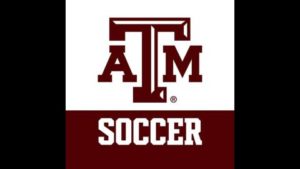Jason Nitsch ’14/Texas A&M School of Veterinary Medicine and Biomedical Sciences
Texas A&M University veterinary student Skyler Adams works at the Stevenson Companion Animal Life-Care Center, providing care to the animals at the facility while living in a rent-free apartment with three other students.
BRYAN-COLLEGE STATION, May 28, 2024 — Each year, four veterinary students at the Texas A&M School of Veterinary Medicine and Biomedical Sciences have the opportunity to live at the Stevenson Companion Animal Life-Care Center, a facility like no other that provides a home for companion animals whose owners have passed away or otherwise have become unable to care for their beloved pets.
The student residents play a vital role in ensuring that the 36 animals living at the Stevenson Center receive the same care and attention that their family home provided. In return, the students live within walking distance of their classrooms in a rent-free apartment, while also maintaining a paying job that allows them to prepare practically for their future as Aggie veterinarians.
Serving An Important Role
The Stevenson Center is currently home to dogs, cats, rabbits, birds and donkeys that all require care for their physical, mental and emotional needs.
Maintaining a loving home for three dozen animals is not an easy endeavor; it requires a team of full-time staff and several undergraduate students in addition to the four veterinary student residents.
The center’s director, Dr. Sam Miller, and those employees take care of the center and its animals during business hours while the veterinary students are in class, but during evenings and on weekends, the student residents are responsible for all of the pets’ feeding, cleaning and medical needs.
Veterinary student residents can live and work at the Stevenson Center during their first three years of veterinary school before leaving to begin their rigorous fourth-year clinical rotations.
“It sounds like a lot of work, but these students are very responsible, and they get into a routine so fast,” said Ellie Greenbaum, the center’s associate director. “They also have such compassion for the animals they’re taking care of. They fall in love with these animals just like we, the staff, do. It’s just like having 36 of your own animals in your house.”
As all pet owners know, taking care of an animal is more than just providing for its basic needs. One of the students’ most important responsibilities is giving each animal love and attention — playing fetch in the yard, providing a warm lap to lay on while studying, and even bringing a favorite pet into their room for a nap.
“Sometimes, it’s a really great reminder of why I wanted to get into veterinary medicine in the first place,” said Emily Read, a second-year veterinary student from Houston who began her time at the Stevenson Center as an undergraduate student. “School is long and hard, and there are definitely days when you just want to come home and curl up with a cat or dog. The Stevenson Center is a nice place to relax and unwind.”
Gaining Practical Experience
Working at the Stevenson Center has many benefits for the student residents, including a regular paycheck and scholarships made possible by center donors. It also provides the perfect opportunity to supplement their veterinary education with real-world experiences.
“They’re learning about the aging process while watching these animals grow up before their eyes, and they’re learning about what you do for different maladies,” Greenbaum said. “Their firsthand experience will play an important role in ensuring they graduate as compassionate veterinarians.”
One of the students’ job duties is performing regular physical exams on all of the pets to assess their overall health and keep track of any age-related changes. The students are also responsible for monitoring the pets’ behavior and informing the center leadership of any causes for concern.
If health concerns arise, the pets are in the best possible hands with the veterinary experts next door at the Texas A&M Veterinary Medical Teaching Hospital (VMTH), which also provides medical care to the animals. Gaining experience as both the clinician and the animal’s caretaker gives the student residents a unique perspective on the importance of communication and client relations.
“I’m learning some of the communication and advocacy skills that are going to make me a very successful veterinarian in the future,” Read said. “Maybe I see things at night that day staff doesn’t have the opportunity to see, so I get to advocate for these animals by explaining what I observe to my bosses.”
The Stevenson Center is home to pets of all ages, but many of the animals are already reaching their senior years when they arrive, so providing care for age-related conditions and other medical needs is a common job duty.
“A very important part of my job is giving medication to the animals,” said fourth-year veterinary student Alexandria Butler, who was a Stevenson Center resident for her first three years of veterinary school. “I use what I’ve learned in my Professional and Clinical Skills courses and Fear Free teachings over these past three years to do this safely. When I am a veterinarian, I plan to keep using these methods and educate owners on ways to safely give their pets drugs in a way that the pet hopefully will tolerate.”
“You learn to navigate as their medical needs change or as they age,” Read added. “You also adapt your approach to their personalities to make sure that they’re comfortable and happy, and you do whatever you can to make treatments go smoother.”
Making Emotional Connections
For the student residents, living with 36 animals truly feels like having 36 of their own pets.
“These are my babies and having that bond with them has been really beneficial in both directions,” Read said. “It gives them a good sense of stability so that this really does become a second family for them.”
The residents also form close bonds with their Stevenson Center roommates and the other staff members.
“My favorite thing about living at the Stevenson Center is all the relationships I have made,” Butler said. “My bosses, Ellie Greenbaum and Dr. Miller, are very kind and supportive. They are always there if I want to have a chat about school or what’s going on in my personal life.”
Of course, that means that when third year is over and it’s time for a student resident to move out, it’s a sad day for everyone involved. Fortunately, in their fourth year, the former student residents often get to help take care of Stevenson Center pets that visit the VMTH for veterinary care.
“We really think of this as a family,” Greenbaum said. “It’s very hard for some of these guys to go into their fourth year and say goodbye because they really do love these animals. I know for a fact that some of our former student residents keep an eye out for our pets and ask to be on their cases when they visit the hospital.”
Even after graduation, the former student residents remain part of the Stevenson Center family. As they begin their veterinary careers, they know that the memories made and the experiences had at the Stevenson Center will provide valuable lessons on which to draw in the years to come.
“My time here is going to benefit me in so many ways,” Read said. “Both the animals and the people here are so special. I’ve known these animals for two years now, and I’m sure the feelings will only continue to grow the longer that I’m here. It’s just so rewarding to come home at the end of each day.”
When pets come to the Stevenson Companion Animal Life-Care Center at the Texas A&M School of Veterinary Medicine and Biomedical Sciences, they become our family, too. For information about giving to the Stevenson Center, please contact the VMBS Office of Development at development-VMBS@tamu.edu or 979-845-9043. You can also support the Stevenson Companion Animal Life-Care Center with gifts of $25 or more online at txamfoundation.com/give.
Courtesy of Megan Bennett




